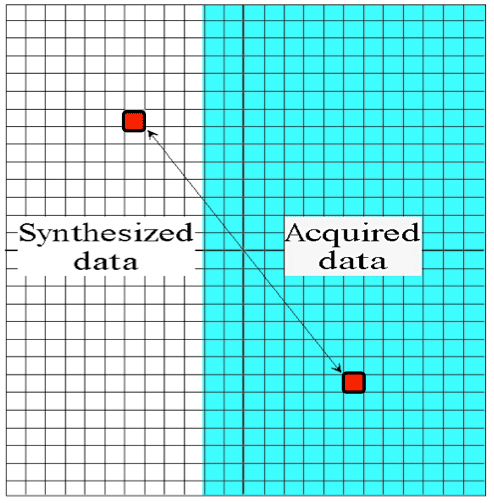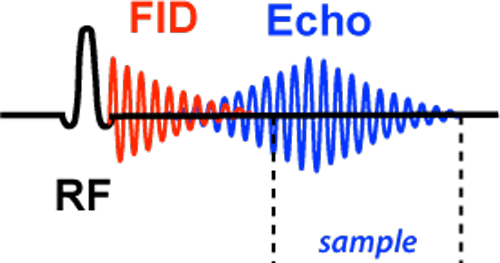Read-conjugate symmetry is a partial Fourier technique where data in one-half of k-space is used to synthesize/predict data in the other half. The direction of symmetry is in the readout (frequency-encode direction).
|
Because the kx-axis is commonly chosen in diagrams to represent frequency-encoding, read symmetry can visualized as acquiring data from the "right half" of k-space and estimating data in the "left half". The sampled "right half" of k-space comes from the later portions of each MR echo.
Vendor nomenclature reflects the fact that only a fraction of each echo is sampled: "Partial Echo" (GE, Philips); "Half Echo" (Hitachi); "Asymmetric Echo" (Siemens). Unlike phase conjugate symmetry, the full number of phase-encoding steps are still acquired in read-conjugate symmetry so there is no direct time savings. |
Why would one want to sample only part of an echo? The answer is that by sampling only part of an echo, the echo time (TE) can be made shorter than would otherwise be possible. This is particularly advantageous for rapid and echo-planar techniques, but is also widely used in many other applications including MR angiography and T1-weighted spin-echo imaging.
|
When echo time (TE) is short, the free induction decay (FID) generated by the RF- pulse may spill into the early rising portion of the echo. By sampling only the back half of each echo and using read conjugate symmetry to reconstruct the front half, we obtain an image with short TE and little interference between the FID and echo signals.
|
Additionally, for a selected echo time (TE), partial echo generates a better signal-to-noise ratio (SNR) by allowing an extending sampling time far into the right side of the echo. Because of the lower gradient amplitude associated with this longer sampling time, read-conjugate symmetry techniques may also allow a smaller FOV at a given echo time, or an oblique scan which might otherwise not be possible. A final advantage of read-conjugate symmetry is that gradient moments are reduced along the readout axis, resulting in reduced flow and motion artifacts in the frequency-encode direction.
Advanced Discussion (show/hide)»
No supplementary material yet. Check back soon!
References
Feinberg DA, Hale JD, Watts JC et al. Halving MR imaging time by conjugation: demonstration at 3.5 kG. Radiology 1986; 161:527-531.
MacFall JR, Pelc NJ, Vavrek RM. Correction of spatially dependent phase shifts for partial Fourier imaging. Magn Reson Imaging 1988; 6:143-145.
McGibney G, Smith MR, Nichols ST, Crawley A. Quantitative evaluation of several partial Fourier recconstruction algorithms used in MRI. Magn Reson Med 1993;30:51-59
Feinberg DA, Hale JD, Watts JC et al. Halving MR imaging time by conjugation: demonstration at 3.5 kG. Radiology 1986; 161:527-531.
MacFall JR, Pelc NJ, Vavrek RM. Correction of spatially dependent phase shifts for partial Fourier imaging. Magn Reson Imaging 1988; 6:143-145.
McGibney G, Smith MR, Nichols ST, Crawley A. Quantitative evaluation of several partial Fourier recconstruction algorithms used in MRI. Magn Reson Med 1993;30:51-59
Related Questions
What is partial Fourier imaging?
What is phase-conjugate symmetry (Half Fourier or ½-NEX imaging)?
What is partial Fourier imaging?
What is phase-conjugate symmetry (Half Fourier or ½-NEX imaging)?


